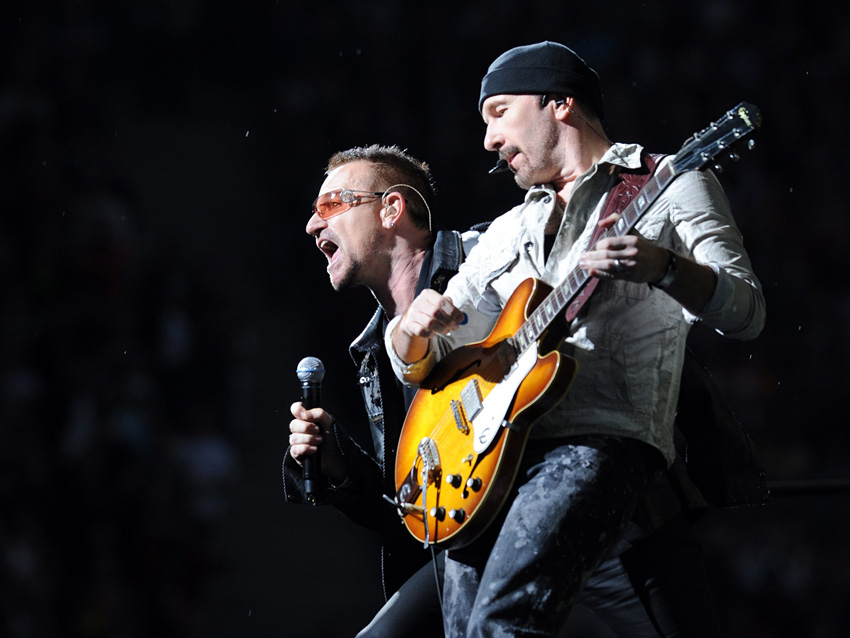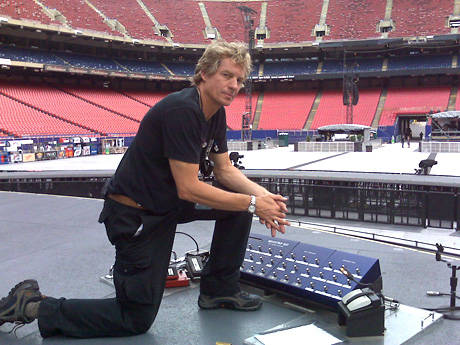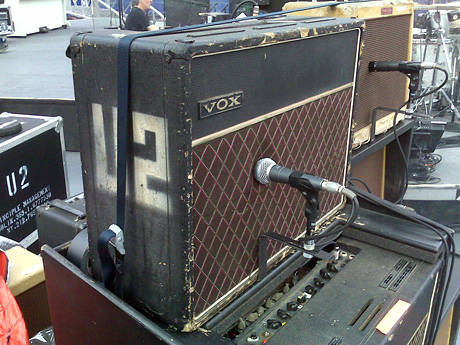Guitars, amps, FX - they're all here!
Joe Bosso, Wed 14 Oct 2009, 1:42 pm BST

Bono and The Edge onstage on U2's current 360° Tour (© A3464 Rainer Jensen/dpa/Corbis)
U2's 360° Tour is a massive operation alright, and it wouldn't be an understatement to call it The Biggest Show On Earth - or anywhere else for that matter.
Named after a stage configuration called The Claw - a towering, robotic-looking structure said to be the largest (and costliest) concert setting in rock 'n' roll history, one that offers stadium audiences a panoramic view of the band - it's a long way from "three chords and the truth."
It's five hours before showtime inside the vast Giants Stadium. The field and seats of the 80,000 capacity venue are empty, but I'm suddenly jolted by an overwhelming blast of music produced by three musicians on stage who proceed to pump out the second-best version of City Of Blinding Lights I've ever heard.
Were they The Edge, Adam Clayton and Larry Mullen Jr, they might take their rendition all the way home, but the trio I'm listening to are their techs, Dallas Schoo, Stuart Morgan and Sam O' Sullivan, respectively.
Still, it's uncanny how much they sound like their bosses. Schoo switches guitars and tweaks some settings on Edge's pedalboard. A few more guitar changes - a Rickenbacker, a Music Rising Les Paul, a black Stratocaster - and song snatches follow (bits of Ticket To Ride, The Rolling Stones' Angie and - WTF? - Stairway To Heaven).
Then Schoo sees me and waves me up on stage. The affable Kentucky native greets me warmly as I tell him he and his fellow techs could form the greatest U2 tribute band around. Schoo laughs heartily. When I ask him if U2 are going to attempt to cover Zeppelin tonight, he laughs again and says, "No, no, no. That's just us having fun. We're testing sounds, but we get to play rock star while we work."
With 43 guitars and a truckload of electronic gear (for the complete, definitive list, see the end of this article) to look after, Schoo just might be the hardest working man in the business. While it's The Edge's job to make sonic magic happen nightly, Schoo is up at dawn, mapping out the agenda for each performance, plotting guitar changes and keeping score of ever-changing effect presets.
Oh, and don't forget changing strings on those guitars - on any given day, he's personally stringing 20 of them. "Most are a breeze," he says. "It only starts to feel like a chore when I'm working on a 12-string."

Dallas Schoo with The Edge's pedalboard, Giants Stadium, New Jersey. Photo: Joe Bosso
Schoo has been Edge's right-hand man since 1986. Having worked with everyone from Hall & Oates to James Taylor, he got a call to meet with U2 while they were finishing The Joshua Tree. But the offer to go on the road with the Irish band was a difficult one to accept. Schoo asked the iconic concert promoter Bill Graham for advice. Graham, who knew stars when he saw them, told Schoo, "These kids are going to be mega."
Twenty-three years later, Schoo is now not only Edge's guitar tech and full-time employee, but a trusted confidante, staying by the guitarist's side at every single concert and recording session. "That's the most amazing thing about Edge and the band," he says, "the amount of faith they'll have in you if you prove your worth. I still pinch myself when Edge or Bono ask me for ideas in the studio. I think to myself, Hey, you're the geniuses. You wrote the song, you play it - I'm just the hired hand here."
Schoo talks into his two-way that he's going to need "an hour or so," and after receiving confirmation from a production staffer that the time is clear, he takes me on a guided tour of the mind-boggling array of amps, effects and guitars that make up The Edge's sound.
I'm still finding it strange to be standing under an enormous claw, Dallas.
[laughs] "It does take a couple of minutes to get acclimated. But you forget pretty fast. It does look pretty awesome at night with all the lights and the video screen."
How is it different for The Edge to work on this kind of stage? There's a lot more room for him to move; everything's a lot cleaner.
"That's true. There's more real estate for him to deal with. He isn't as tied to one little area and he doesn't stand next to his pedalboard as much as he used to. That's great in one way because it gives the crowd a very lively show, but it presents sound issues he and I had to figure out.
"During our production rehearsals in Barcelona, when we saw the stage for the first time and the band started getting familiar with it, Edge asked me if I could handle most of the show - meaning, could I man the switching of effects but keep up with the guitars?
"Edge is very guitar-specific. Last night he used 21 different guitars for 24 songs. He's more tuned into the sound of each guitar than he ever was on any other tour. So I've got to stay focused every second. I have to always be ready with a new guitar, and I have to be ready for all of the effects cues."
[Pointing to the large Skrydstrup switching system] But he does have his own pedalboard. He is working his own effects some of the time, right?
"Yes, he is, but every time he walks away from the pedalboard, which is often, it's all on me. And let me tell you, this tour has been a challenge in that respect. During a show, when I'm down there [he points to the stairs that lead underneath the stage], all I have is a six-inch window to look up at him through."
A six-inch window? How can you see him all the time?
[laughs] "I can't. Not all the time. It isn't easy. And what makes it even more difficult is, for the first time ever, Edge has a wireless headset mic so he can sing and work the stage. In the past, he could back off the mic and give me cues. Now he has to try to put his hand over his mic and give me directions, or he tries to do it with certain facial expressions."
How long does it take for you and Edge to be in sync? How long is the rehearsal process between the two of you?
"It can take several weeks. And things change while we're on tour. Certain songs come and go. The good thing is, I've been with him for so long, so there's a history between us. We have a shorthand."
Take me through the amp setup you have here.
"Well, of course we have the main AC30 from '64. Can't do a show without that. Then we have a '58 Fender Deluxe with a Vox speaker and a '57 Deluxe with a Jensen speaker. From there we go to a mid-'50s Fender Harvard - a very rare amp, by the way, and it sounds fantastic - and I put a Vox speaker in that. Plus, we have some early '70s Vox amps as backups."

The heartbeat of Edge's sound, his 1964 Vox AC30TB. Photo: Joe Bosso
But the main star amp-wise is the '64 AC30.
"Absolutely. It's the basis for The Edge's sound, live and in the studio - well, aside from what's in his head and his hands and just the magic he brings to what he does."
Let's go through some specifics of the amp. It's what's known as an 'AC30TB.'
"That's right, it's a 'Top Boost.' The chassis is 1964 but it's housed in a 1970s cabinet - this I how the amp came when Edge originally purchased it. The speakers are a Jensen Blue Alnico 12" from the '60s and a Silver Jensen Alnico 12". I replaced a Blue Alnico in early 1986 for the Silver Jensen because the blue one blew out and that's what I had in the U2 Dublin storage as a replacement."
Could Edge tell the difference between the two speakers?
"Totally. He knows any kind of change I make to that amp. Nothing gets by him. Luckily, he likes the speaker combination, so we stuck with it."
...
No comments:
Post a Comment